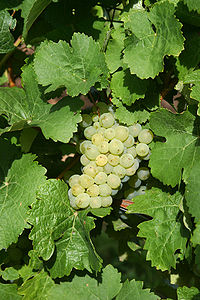Osteiner
Osteiner is a white wine variety . It is a cross between Riesling and Silvaner , which Heinrich Birk carried out at the Geisenheim research institute in the Rheingau in 1928. The information provided by the breeder about the parents of the cross has been confirmed by DNA analysis in the meantime.
It was only granted plant variety protection in 1984 and was entered in the list of varieties in the same year .
The vigorously growing vine hardly develops any stinging shoots , which makes it less susceptible to powdery mildew and fungi. It makes no special demands on the soil, is hardy even in severe frost, flower-proof and therefore high-yielding. It produces strong, full-bodied wines with a Riesling taste, but stronger acidity (→ acidity (wine) ).
Osteiner is a variety of the noble grapevine ( Vitis vinifera ). It has hermaphroditic flowers and is therefore self-fruiting. In viticulture , the economic disadvantage of not having to grow male plants that produce yield is avoided.
The cultivation area in Germany is limited to about four to five hectares in the Rheingau , in Franconia and on the Hessische Bergstrasse . It is also approved in the Ahr , Middle Rhine , Moselle , Nahe , Palatinate , Rheinhessen and Saxony wine-growing regions . The importance of the vine can be classified as low overall. Small stocks are also known in New Zealand.
See also the articles Viticulture in Germany and Viticulture in New Zealand and the list of grape varieties .
Naming
The Counts of Ostein , who resided in the Rheingau until the beginning of the 19th century , were the inspiration for the naming . The last of this tribe, Count Johann Friedrich Karl Maximilian Amor Maria (1735–1809) is particularly connected to Geisenheim through the construction of the Palais Ostein and the creation of a landscape park .
Synonym : Geisenheim 9-97
Parentage : Riesling x Silvaner
Individual evidence
- ↑ Erika Maul, Fritz Schumann, Bernd HE Hill, Frauke Dörner, Heike Bennek, Valérie Laucou, Jean-Michel Boursiquot, Thierry Lacombe, Eva Zyprian, Rudolf Eibach, Reinhard Töpfer: Focus on the crossing parents of German new varieties of vines - what does the genetic fingerprint say. In: German Viticulture Yearbook. Vol. 64, 2013, ISSN 0343-3714 , pp. 128-142.
Web links
- http://www.campus-geisenheim.de/index.php?L=0&id=1818 Osteiner on the website of the Geisenheim research institute.
- Osteiner in the database of the Geilweilerhof Institute for Vine Breeding .
literature
- Pierre Galet : Dictionnaire encyclopédique des cépages. Hachette, Paris 2000, ISBN 2-01-236331-8 .
- Walter Hillebrand, Heinz Lott, Franz Pfaff: Paperback of the grape varieties. 13th, revised edition. Fachverlag Fraund, Mainz 2003, ISBN 3-921156-53-X .
- Jancis Robinson , Julia Harding, José Vouillamoz : Wine Grapes. A complete guide to 1,368 vine varieties, including their origins and flavors. Ecco, New York NY 2012, ISBN 978-0-06-220636-7 .
